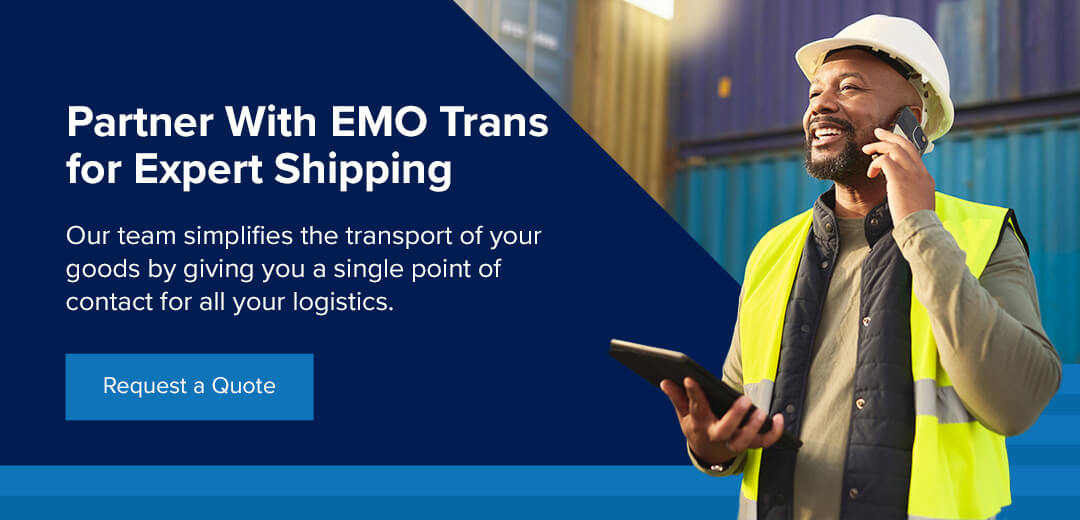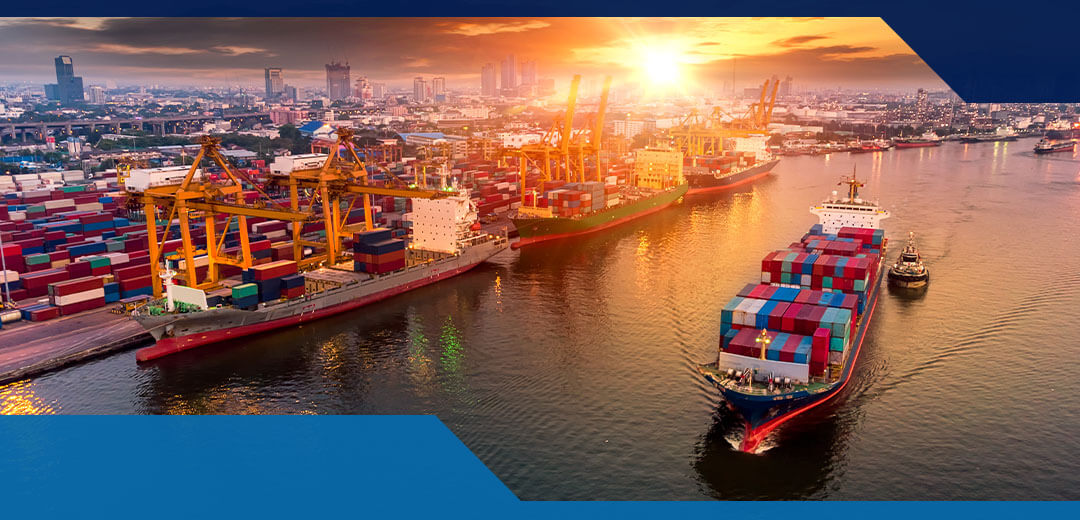
Freight shipping is full of acronyms, but what do they mean, and how do you choose the best option for your cargo? Whether you are managing domestic deliveries or international shipments, this guide is here to help you navigate the complexities of freight transportation.
When it comes to shipping products, raw materials or manufactured components, understanding the different options available to you can have a massive impact on cost and efficiency. Two primary methods of shipping freight are by sea and road. You will come across four key terms — full-truckload (FTL), less-than-truckload (LTL), less-than-container load (LCL) and full-container load (FCL) — when considering these logistics modes.
Knowing how these methods differ will help you choose the best option for your shipping needs, whether you need to ship a small batch of products or a large quantity of goods.
Understanding Available Shipping Methods
Do you plan to move goods by land or water? Aside from the volume of goods you are shipping, evaluating whether truckload or container options are best for your needs depends on several key factors:
- Distance and destination: Sea shipping is ideal for international and long-distance shipments. Shipping via trucks is more practical for regional deliveries in the same country or on the same continent.
- Cost: Shipping large, heavy loads in containers is more cost-effective. The prices often work out to be more inexpensive per unit of weight or volume. With tolls, fuel and labor costs, road shipping can be expensive for long distances but very cost-effective for shorter hauls.
- Speed: It can take several weeks to ship via ocean freight. Trucks move faster over shorter distances and provide more accurate delivery schedules. It is the better choice when time is a critical factor.
- Type of goods: Sea shipping is suitable for bulky, heavy and non-perishable goods. Time-sensitive goods or products that need faster delivery are better suited for shipping via truckload.
- Flexibility: Ocean shipping could be more flexible as it works on fixed shipping routes and schedules. Trucking is more flexible, allowing for last-minute adjustments and direct deliveries to specific locations.
- Accessibility and infrastructure: Ships require access to ports, which can involve additional logistics like customs clearance and port handling. Trucks use a well-developed road network, and delivery is simple when destinations are easily accessible by road.
Freight Shipping Glossary
There are various terms associated with freight and shipping, but the key terms to familiarize yourself with include:
- Consignee: The consignee is the person or company receiving the shipment.
- Bill of lading (BOL): The BOL is a contract between the shipper and carrier that details the quantity, type and shipping destination.
- Drayage: Drayage is transporting goods over a short distance as part of a longer, overall journey — for example, between a port and a warehouse.
- Carrier: This is the company or entity tasked with transporting goods.
- Hub: The hub is a central point in the transportation network where goods are collected, sorted and dispatched.
- Dimensional weight (DIM weight): This is a pricing technique that uses the package volume to determine its weight. It is used for large but light packages.
- Freight forwarder: The freight forwarder is an intermediary that arranges transport for shippers and handles associated paperwork. It is mainly used in international shipping.
Road Freight
Road freight plays a vital role in logistics. In 2022, trucks transported just over 72% of the total domestic tonnage shipped in the United States. Your business can ship using a full truck, or buy a portion of space in the truck, sharing with other customers who also want to ship small consignments.
What Is Less-Than-Truckload?
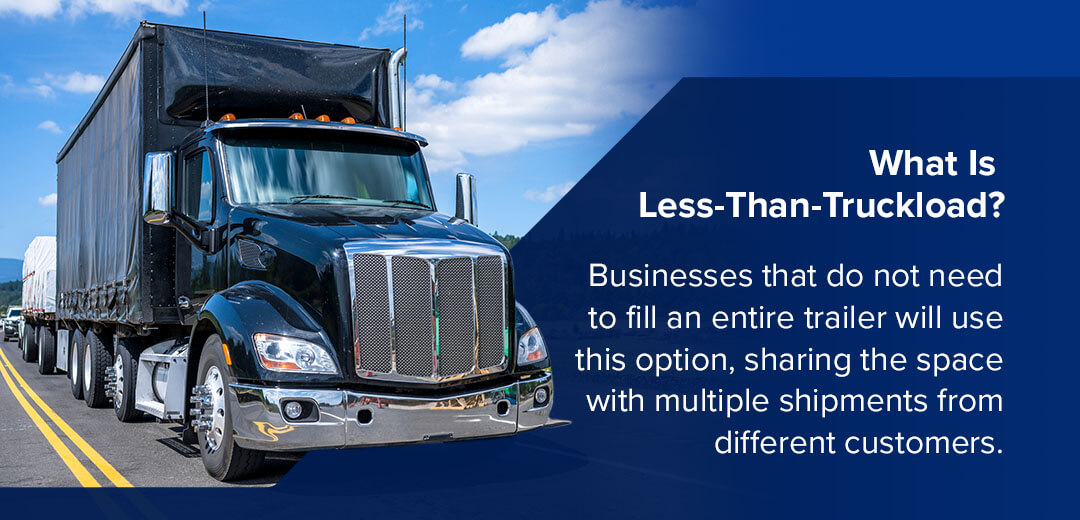
Less-than-truckload (LTL) shipping is a cost-effective way to move smaller shipments. Businesses that do not need to fill an entire trailer will use this option, sharing the space with multiple shipments from different customers. These shipments usually take up less than 11 feet of trailer space, weigh under 10,000 pounds and are billed based on occupied space.
Businesses with small or irregularly timed shipments or varying shipment sizes benefit the most from LTL shipping. It offers the flexibility to ship as needed without waiting to accumulate enough goods to fill a truck. Sharing space with other shipments also saves you money as you are not paying for unused truck space.
LTL carriers have regular freight schedules, so if your business needs consistent restocking, LTL shipping is the right choice. Combining shipments reduces the number of trucks on the road, lowering carbon emissions and fuel consumption.
When you request LTL shipping services, carriers require a freight classification to give you an accurate quote. Freight classification is a standardized method that defines LTL freight price based on its ease of movement. A shipment’s density and liability risk determine its freight class, handling requirements and stowability.
What Is Full-Truckload?
In trucking, full-truckload (FTL) shipping means using an entire truck to ship products for a single client, often when there are 10 or more pallets to ship. It gives you more control over the shipping process. FTL shipping is fast, as trucks travel directly to their destinations without unnecessary stops. Direct routing like this makes FTL ideal for urgent deliveries.
FTL is best for high-volume shipments because it streamlines logistics efficiency and processes. It also offers better security thanks to less handling and fewer stops, which is especially beneficial for sensitive or valuable goods. The one-shipment nature of FTL shipping means less cargo handling, minimizing the risk of damage during loading and unloading at multiple stops. With a dedicated truck, FTL shipping schedules are straightforward, offering reliability and consistent, predictable delivery times.
Sea Freight
Sea freight is a cornerstone of global trade, shipping 90% of the world’s goods — most of which are packed into steel containers. You can choose to purchase an entire container dedicated to your goods only or share cargo space with other businesses. Insight into these differences will help you optimize your supply chain.
What Is Less-Than-Container Load?
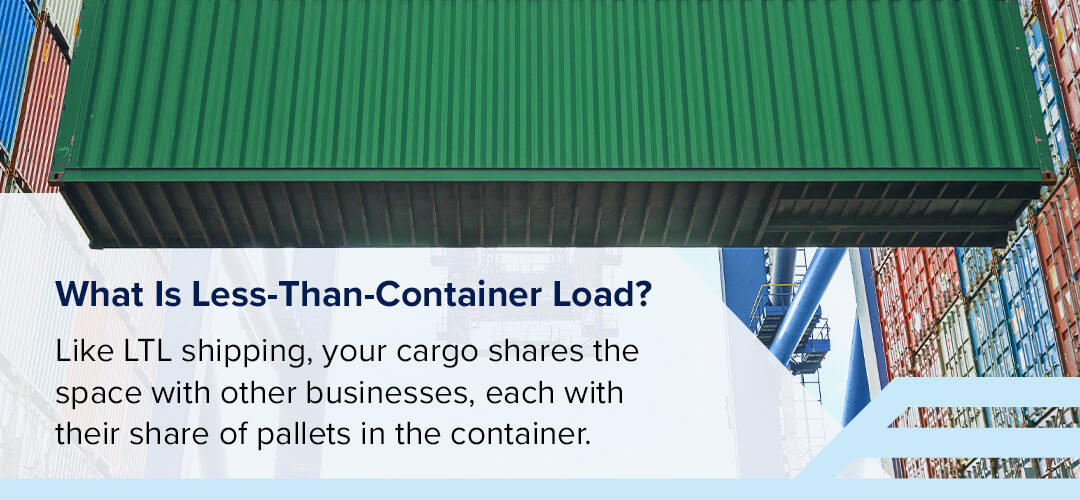
Less-than-container load (LCL) shipping is used to transport smaller loads that only fill part of the container. Like LTL shipping, your cargo shares the space with other businesses, each their share of pallets in the container. A freight forwarder typically handles this consolidation process to ensure all items are packed efficiently and securely. LCL shipments bill per full-form cubic meter (CBM), which includes local charges for outgoing and incoming ports.
As this approach involves consolidating and de-consolidating multiple shipments, planning and allowing extra delivery time is essential. LCL shipments also require accurate documentation and compliance with customs regulations. For this reason, it is necessary to work with an experienced freight forwarder that can ensure the shipment clears customs smoothly.
What Is Full-Container Load Shipping?
Full-container load (FCL) shipping transports cargo internationally, filling one container with freight from a single shipper. The container is sealed and shipped directly to the recipient without being opened during transit. It is a cost-effective way of moving a large volume of goods in one go, so long as you use the entire container. Otherwise, you pay for unused space.
How to Choose the Right Freight Option
Choosing the right freight option is essential when you are optimizing your logistics operations. Each method has unique benefits, but how well they suit your shipping needs depends on the following factors:
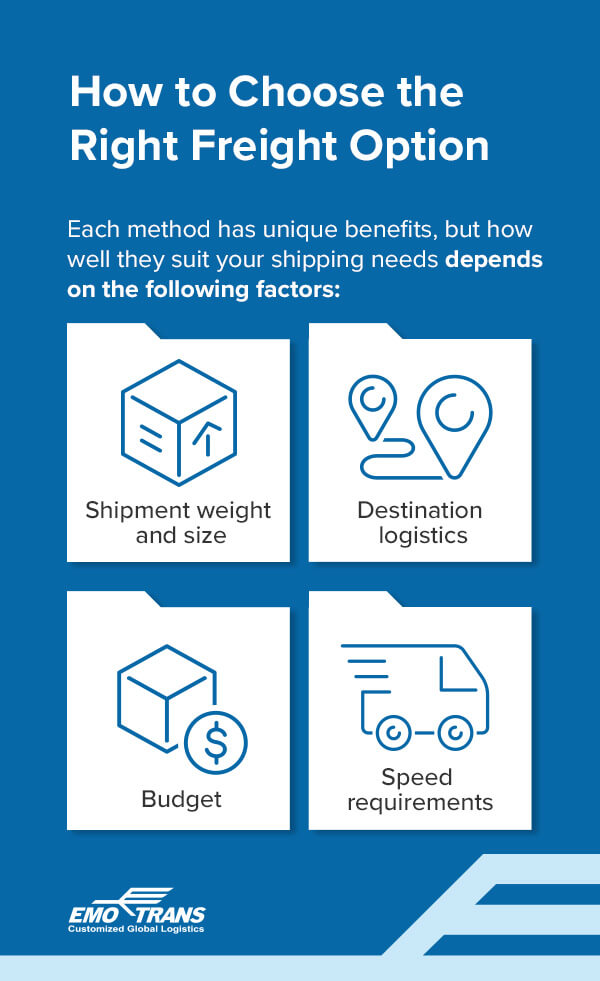
- Shipment weight and size: Small loads may benefit from LTL or LCL, while large shipments will benefit from FTL and FCL shipping.
- Destination logistics: If you are shipping to remote locations or international destinations, you may have to use ocean freight.
- Budget: Selecting a shipping method that suits your shipment size will ensure a cost-effective option.
- Speed requirements: FTL and FCL are generally the fastest shipping options.
LTL and LCL are renowned for cost-effectiveness and potential consolidation benefits. FTL and FCL shipping are generally faster and offer shippers dedicated space for their goods. Here is a comparison chart to help you visualize these shipping options:

Frequently Asked Questions
Understanding common freight options like LTL, LCL, FTL and FCL empowers you to optimize your business’s logistics operations. The answers to these frequently asked questions clarify each shipping method to aid your decision-making process:
What Is the Difference Between LTL and FTL Loads?
FTL means reserving a whole truck for one shipment to maximize space and secure direct delivery with no stops. When you are only going to fill a portion of the truck and want to share the cost of the truck rental with other customers, opt for LTL shipping.
Is FTL More Expensive Than LTL?
FTL shipments tend to be more expensive than LTL shipments, as you book an entire truck. However, it is important to match shipping to your needs, as the cost-effectiveness of one method over another depends on the size of the goods you are shipping.
What Is the Difference Between LCL and LTL?
LCL means you share a shipping container with multiple customers, making it a cost-effective option for smaller ocean freight shipments. LTL shipments are for road freight that does not require a full truck. It shares the shipment with other customers, splitting the cost according to the space your cargo uses.
Why Is LCL Cheaper Than FCL?
LCL is great for shipping lower volumes, but remember that local charges and freight costs can be higher than FCL when you compare the CBM rate. Always compare LCL and FCL pricing when your quote includes an extremely high CBM.
How Do You Choose FCL or LCL?
Use LCL shipping for low-volume loads, usually between 2 and 13 cubic meters. Use FCL for shipments over 13 cubic meters. In this case, the best choice is the option that gives you the best value for money while meeting additional needs like handling and delivery times.
When Is FCL Shipping the Best Option?
FCL shipping can be costly if you have too little cargo to fill a container, which leads to underused space. Choose FCL shipping when you can fill a container or need added security and control over your shipment. It is also faster, as the container goes straight to its destination.
Partner With EMO Trans for Expert Shipping
Choosing a shipping method — whether FTL vs. LTL or LCL vs. FCL — depends on your needs. Simply put, LTL and LCL are cost-effective options for smaller loads, whereas FTL and FCL are ideal for large shipments. Understanding these options will help you make informed decisions that ensure your goods are transported cost-effectively and efficiently. Selecting the right method allows you to optimize your logistics operations to better serve your customers.
As a leader in global logistics, EMO Trans will work with you to develop customized logistics solutions that suit your needs. With over 55 years of experience and 250 global network offices, your cargo is in safe hands. We also have various certifications and accreditations, including ISO 9001:2015, Customs Bonded warehousing and Good Distribution Practices. Our team simplifies the transport of your goods by giving you a single point of contact for all your logistics.
Request a quote today.

